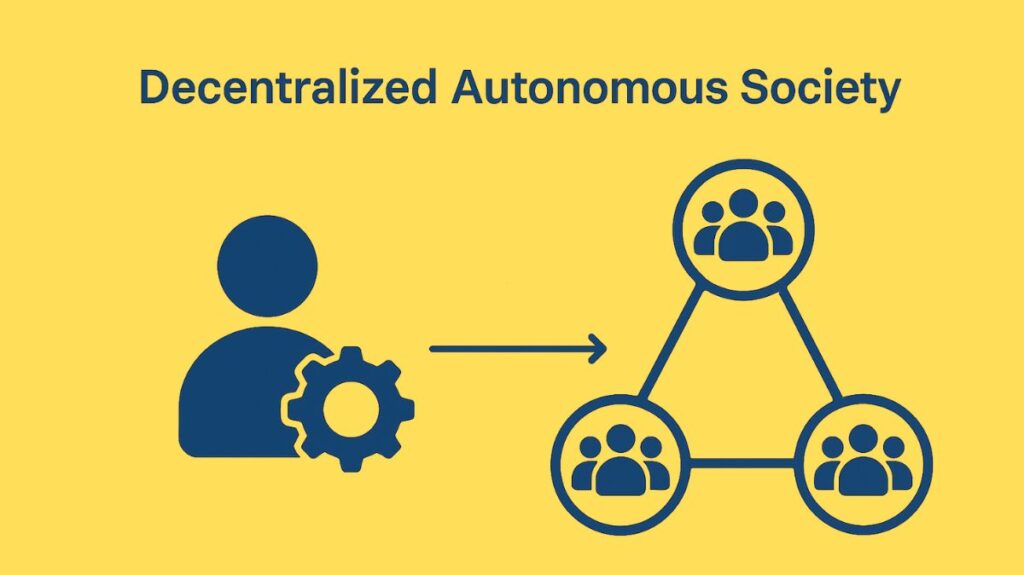Decentralized Autonomous Society
A Decentralized Autonomous Society (DAS) is a ground-breaking idea for human cooperation and organization. It is a self-governing community that functions according to established norms and incentives without the need for middlemen or centralized authority. It imagines a whole society running on a blockchain, with direct control over procedures given to involved citizens, greatly diminishing the role of conventional government.

Fundamental Definition and Function
- A Decentralized Autonomous Society is fundamentally a community with incentives and regulations enshrined in blockchain-based smart contracts. This makes a transparent, decentralized, and safe data container possible.
- Without the need for centralized leadership or control, members work together to accomplish common objectives, reach decisions as a group, and manage resources.
- A Decentralized Autonomous Society would be made up of a number of intricate smart contracts, different Decentralized Autonomous Organizations (DAOs), and Decentralized Applications (DApps) that would all run independently on a blockchain.
Core Principles and Mechanisms DAS
Fundamental Mechanisms and Principles Decentralized Autonomous Society are based on a number of fundamental ideas:
- Decentralized Governance: This is a distinguishing characteristic that allows members to establish policies and make choices collaboratively without depending on centralized authorities. Voting procedures are usually used to make decisions, and each member’s influence is frequently proportionate to their contribution or stake. To make sure decisions represent the will of the community, a variety of models, such as futarchy, simple majority, and quadratic voting, can be employed.
- Smart Contracts: These are self-executing blockchain programs that automate a Decentralized Autonomous Society’s agreements, regulations, and incentives. They minimize mistakes and eliminate the need for middlemen by offering a visible and impenetrable means of enforcing community rules consistently and impartially.
- Tokenized Incentives: Cryptocurrency or native tokens are used to reward contributions and align incentives. These tokens, which can be obtained by involvement, such as donating labour or resources, signify a stake in the community. They prohibit activities that are detrimental to the community and promote constructive behaviour.
- Permissionless Participation: Decentralized Autonomous Society are open to anybody who follows the community’s norms and provides resources. Blockchain technology reduces intermediaries and fosters global cooperation.
- Transparency and Accountability: Anyone can audit and confirm every legislation, choice, and action on a public blockchain. In addition to encouraging people to behave honestly, this builds trust and produces useful data for tracking and development.
DAS Features
Key Features Several important characteristics define a DAS:
- It is a new theory.
- It is primarily software-based and autonomous.
- It is not held by a single entity, in contrast to typical entities.
- Although its legal status is still up for debate, it might include capital.
- It is regarded as being reasonably priced.
- Its goal is to change how people interact and communicate in society.
Purpose and Transformative Potential
- DAS has broad and revolutionary ramifications that allow for resource allocation and trustless collaboration. They can transform our relationships, career, and lives.
- This paradigm suggests that blockchain technology could replace government services including identity cards, passports, and birth, marriage, and deed records.
- The idea presents a “parallel reality” fuelled by openness and decentralized consensus, which is especially pertinent in situations when a government is seen as corrupt or where central systems are unable to deliver sufficient trust.
- This concept is frequently referred to as a “libertarian’s or cypherpunk’s dream,” since it frees people from hierarchical power systems and permits direct involvement in decision-making, empowering them to build their own economies without the need for middlemen.
DAS Benefits
DAS has many advantages, such as:
- Enabling permissionless, worldwide cooperation.
- Lowering the expenses and inefficiencies brought on by centralized bureaucracies.
- Granting more responsibility and transparency.
- Enabling people to participate in the institutions and communities that are important to them.
Challenges
Notwithstanding their enormous potential, DAS also face several obstacles, including scalability problems, complicated user interfaces, unclear regulations, and the possibility of malevolent actors taking advantage of weaknesses.
